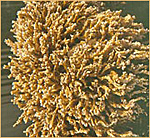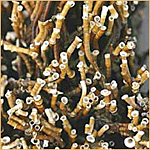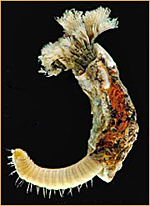|
|
 |
 |
|
|
 |
 |
 |
|
Member of the Wildlife & Environment
Society of South Africa Western Cape Region
|
 |
|
|
|
| Eco Bites |
 |
|
Ficopomatus enigmaticus - the estuarine
tube worm |
 |
|
The estuarine tube worm (or Australian
tube worm) has become a major nuisance
in the lower Diep River estuary,
particularly in the area around the wooden
bridge and the Woodbridge Island Road
bridge. Native to Australia,
Ficopomatus enigmaticus has
probably been most often introduced to
new regions as fouling on ship and boat
hulls, though some of its transport may
have occurred as larvae in ballast
water, or in some cases as fouling on
transported oyster shells. In South
Africa it was first noticed in the Cape
Town area in 1951, and now occurs mostly
in estuaries in the Cape Peninsula and
along the south coast. |
|
Read more about the biology of
Ficopomatus enigmaticus. |
 |
|
Ficopomatus enigmaticus builds and lives
in white, calcareous tubes that are
about 2 mm in diameter and a couple of
centimeters long. The tubes are somewhat
flared at their open ends, and have
conspicuous, collar-like rings or
flanges spaced irregularly along their
lengths. Older tubes are typically
stained a gold-brown or dark brown along
much of their length, with the areas
around the flanges and the flared ends
usually remaining white. |


 |
|
To feed, Ficopomatus enigmaticus
extrudes a crown of 12-20 gray, green or
brown branching gill plumes out of the
open end of the tube. Cilia on the
plumes move currents of water upward
through them, oxygenating the blood
within. Other cilia capture small food
particles and pass them down to the
mouth at the base of the plumes. When
disturbed, the worm pulls the plumes
quickly back into its tube and closes it
with a funnel-shaped stopper, called the
operculum, at the end of one modified
gill plume. The top of the operculum
bears numerous, small, black spines. The
worm is usually about 2 cm long,
including the operculum. |
|
Ficopomatus enigmaticus grows in the low
intertidal to shallow subtidal range on
rocks, concrete, wood, shells and other
hard surfaces, including pilings and the
sides of floating docks, buoys and boat
hulls. It can occur as single, separate
tubes, or as tangled, agglomerate masses
that form incrustations up to 10 cm or
more thick. |
|
It can survive in ocean salinities, but
grows and reproduces only in lower
salinities of about 10-30 ppt, and
temperatures above 18° C. To spawn, eggs
and sperm are released into the water
where fertilization occurs. The larvae
develop in the plankton, and after 20-25
days settle on and attach to an
appropriate hard surface. |
|
In colder areas the tube worm colonises
water heated by power plant discharges
and can cause problems when the growths
block the discharges or intake pipes. In
the Netherlands it clogs and interferes
with the operation of locks. However, it
has been suggested that large
populations of Ficopomatus enigmaticus
may remove suspended particulate matter,
reduce excess nutrient loads and improve
oxygen levels in boat basins or enclosed
waters with poor water quality. Serious
studies have not been done on the
ecological effects, but there are
suggestions that it competes for
available food resources with other
filter feeders if the colonies become
extensive. |
|
Control of Ficopomatus enigmaticus is
fairly easy as large colonies can be
removed mechanically or manually.
However, with mobile larvae and a rapid
growth rate, colonisation occurs quite
quickly and continued control is
required to keep areas clear of this
tube worm. |
 |
Compiled by Niel van Wyk with
information sourced from the website:
http://www.exoticsguide.org/species_pages/f_enigmaticus.html
May 2011. |
 |
|
|
 |
|
|